By Shabna Ullah
Moraikobe, a small community located about 96 miles up the Mahaicony River, is home to over 1,200 Amerindians who earn their living mainly through logging and to a lesser extent, fruit and provision farming.
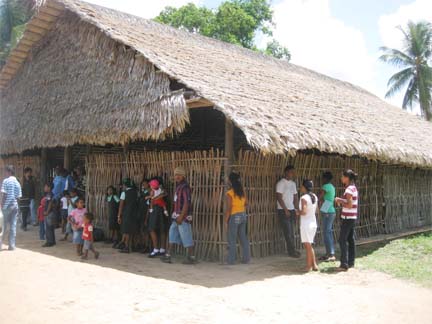
A speedboat, transporting media persons along with Minister of Agriculture, Robert Persaud and team, left a landing at Esau and Jacob, Mahaicony around 8.30 am and arrived at Moraikobe around 10 am.
Because the water in the creek was low, owing to the current El Nino phenomenon, the boat could only go as far as Yarrida Landing, where everyone disembarked and continued the journey by land.
After a short wait a pick-up, owned by a logger in the community, arrived and the three women on the trip were given the privilege of sitting in front of the double-cab vehicle while the men rode at the back along the bumpy sand trail. In about 15 minutes we were at Central Moraikobe.
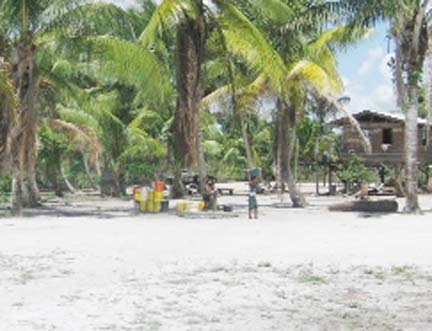
The community was once called St Francis as it is near the Francois Creek, but is now referred to by its original name – Moraikobe – which is derived from the Arawak word Morakuba meaning the heart of mora.
Residents said a big mora tree was once located in the Francois Creek near the Central Moraikobe landing. Even though the tree no longer exists its huge stump still remains at the spot.
There are also two other communities situated about five miles from the central area; Kamwater which has a small population of 50 and Bullet Wood where about 250 persons reside.
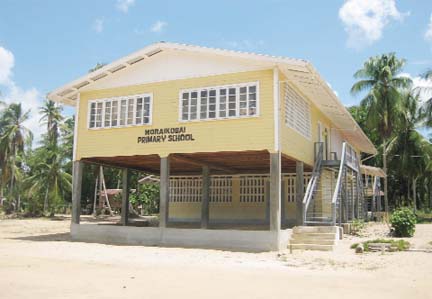
Those residents have to traverse a mud road on foot to access health care, while some 50 school children have to start walking the distance every morning from around 6:30 to get to school on time.
During the rainy weather the road is almost impassable and students have to trek through thick mud. By the time they get to school they are tired and unable to work and residents are calling on government to provide a boat to assist them.
Dereck John welcomed us warmly and introduced himself as the Toshao. Hospitable staff from the Moraikobe Guest House then invited us in for snacks and to freshen up.
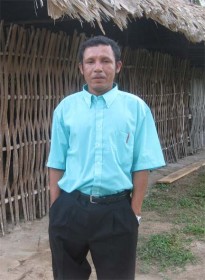
Most of the villagers were seated inside a large benab, which is used for training programmes on the techniques of farming, pest control and animal rearing by staff of the Agriculture Ministry and the Guyana Forestry Commission (GFC).
There was a mini exhibition, showcasing locally grown produce and craft items including jewel boxes, place mats, glass rests, fans and hammocks that were skillfully designed by the women in the community.
El Nino
Using locally grown tibisiri straw they developed their skills on their own. They told this newspaper “we just have to look at somebody making something one time and learn how to make it.”
Their only problem is that there is no market for their products, but they said they hoped this would change soon.
Meanwhile, John said they were facing challenges from the “hard, dry season [El Nino] which is affecting our crops.” He pointed out that they were not reaping the large amounts of produce they were accustomed to and the dry weather was also causing the produce to “die early.”
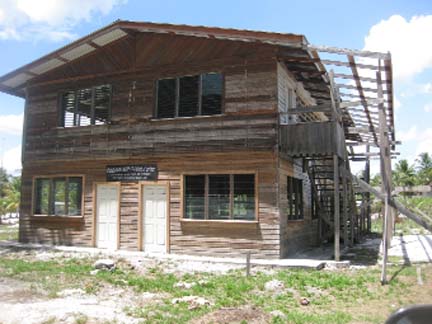
According to him, “it is discouraging to invest in the crops and we are not getting the kind of results we expect.”
El Nino has also resulted in a lot of bush fires in the savannahs.
The Toshao noted that while some of the fires start naturally others were because of the negligence of some residents who had dropped lit cigarette butts.
He said they are trying to sensitize persons to be more careful when disposing of their cigarette butts as their actions can be very destructive. He noted though that residents have been adhering to the warnings and leaders were trying to have the fires under control.
John said they also recognized the effects of global warming and climate change and the importance of the forest. Based on the training from the GFC, they would now “use our forest in a more sustainable way.”
He said they were also told to obey the “rules and regulations of forestry so that we would not get problems in harvesting our forest.
“That is why we are now trying to divert from the forest and go into commercial agriculture.”
Recognizing that it is not a government problem, but a global one, he said they “still need the government to assist us because basically we are very poor people and that is what we depend on to provide food for our families and to generate funds.”
Minister Persaud assured the residents that they would get the required support. He encouraged them to get involved in large-scale farming including rice and presented them with a quantity of fruit and vegetable seeds, chemicals to deal with acoushi ants along with two breeding pigs.
John said farmers were happy that technical personnel were in the area and he was confident that the training would be fruitful as farmers were eager to learn how to deal with the effects of El Nino.
Transportation woes
The farmers said they were also facing difficulties with the high cost of transporting their produce to the marketplace on the coast to sell. They expressed hope that government could assist in providing a “proper public transportation.”
The cost of using the launch service to transport forest and agricultural produce is $80,000 to $90,000 while speedboats cost about $50,000, depending on the size of their engines. Residents said the owner of the launch would humiliate passengers and instead of allowing them to use the seats in the launch, order them to sit on the attached pontoon with their cargo.
Farmers also called for an access road to be built from Moraikobe to Linden as it would give a boost to the community in terms of large-scale farming and would also act as a means of encouraging visitors.
A few women who this newspaper spoke to said they would pay $6,000 for a return trip with the launch which leaves in the afternoon and arrives at Mahaicony the following morning.
Passengers are only allowed to travel with a “small hand luggage and we cannot even bring foodstuff for home use. If we do that we have to pay extra.”
The community has a health centre with three health workers from the community and a medex from out of the area. It also has one nursery and one primary schools, a village office, well equipped sports club and a Christian church.
It also has a public telephone service and a well which has been out of operation for almost two years.
The village council would pump water every two days and residents would have to go to the public standpipes located within each area, with their containers to fill them up.
Low voltage
Residents were elated when the area was served with electricity about five years ago and most of them invested in freezers and other home appliances. However, they only benefit from the service for four hours at night and have been plagued by low voltage for more than a year now, which makes them unable to use their home appliances. Some of the freezers have even been damaged.
Government has provided the community with computers and the computer laboratory is being housed temporarily at the school until a building, which is being constructed for that purpose is completed. Because of the unreliable electricity supply, government also made a generator available to power the systems.
Residents said they were grateful that the Board of Industrial Training (BIT) through the Ministry of Labour has been conducting the National Training Programme for Youth Empowerment for school-dropouts in the area.
They are being trained as mechanics, teaching assistants, nursing assistants and medical laboratory assistants. However, there are no jobs in these disciplines in the community for them once the programme is completed.
Nevertheless, a multipurpose building is being constructed to help early school leavers and persons who have not excelled academically to do computer training, tailoring, joinery, carpentry and other courses.
Remington Adrian, 26, leader of the youth group is responsible for the project which was funded by the United Nations Development Programme (UNDP) under the social cohesion programme.
The women said too that most of the children who pass the National Grade Six Assessment exams are unable to attend secondary school as the Amerindian living quarters on the coast are “cramped. Every year we getting passes but not every year the children can come out.”
They also said that they do not have sufficient financial resources to send their children to secondary schools or to pay care-givers. They are also asking government to provide them with land on the coast so they can stay with their children while they attend school.
A secondary school is needed in the area but residents are aware that it would not be feasible because of the small population. The Region Five administration is currently extending the dormitory at Mahaicony to facilitate some of the students.
Ministers walk the trail
Also on the trip was Jamaican Minister of Commerce Michael Stern who was in Guyana on a personal business trip along with a business partner who grew up at Mahaica Creek.
The children were fascinated with the cameras when they saw us taking pictures and one little girl even posed for a shot.
We left the area around midday as John and the other residents waved goodbye. But that was after the team sampled the locally prepared dishes, cane juice and coconut water.
Takeaway lunches were prepared for the two ministers and two of Persaud’s staff after they opted to walk the trail to see how much distance they could cover until the vehicle caught up with them. Half an hour later we made our down the trail but they were nowhere in sight. We wondered whether they had gotten lost or if they had reached the landing already.
However, as the driver blazed through the trail we saw them running frantically through the bushes from another trail shouting at us to stop. Stern was in front. They must have taken the wrong trail even though they did not say so. We had a good laugh but nevertheless felt they were very brave to have attempted the trek.
Even though I would have preferred to remain at home and relax that day – a national holiday – I was glad I made the trip as it was worth every minute of it.

